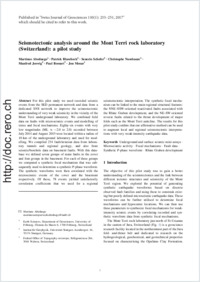Seismotectonic analysis around the Mont Terri rock laboratory (Switzerland): a pilot study
- Abednego, Martinus Earth Sciences, Department of Geosciences, University of Fribourg, Switzerland
- Blascheck, Patrick Institut für GeophysikUniversität Stuttgart, Germany
- Schefer, Senecio Federal Office of Topography swisstopo, Wabern, Switzerland
- Nussbaum, Christophe Federal Office of Topography swisstopo, Wabern, Switzerland
- Joswig, Manfred Institut für GeophysikUniversität Stuttgart, Germany
- Bossart, Paul Federal Office of Topography swisstopo, Wabern, Switzerland
- Mosar, Jon Earth Sciences, Department of Geosciences, University of Fribourg, Switzerland
-
01.04.2017
Published in:
- Swiss Journal of Geosciences. - 2017, vol. 110, no. 1, p. 233–251
Underground and surface seismic mini-arrays
Microseismic activity
Focal mechanisms
Fault data
Synthetic P-phase waveform
Rhine Graben development
English
For this pilot study we used recorded seismic events from the SED permanent network and data from a dedicated SNS network to improve the seismotectonic understanding of very weak seismicity in the vicinity of the Mont Terri underground laboratory. We combined field data on faults with microseismic events and modelling of stress and focal mechanisms. Eighty-six events with very low magnitudes (ML ≈ −2.0 to 2.0) recorded between July 2014 and August 2015 were located within a radius of 10 km of the underground laboratory and used for modelling. We compiled 234 fault/striation data from laboratory tunnels and regional geology, and also from seismic/borehole data on basement faults. With this database we defined seven groups of main faults in the cover and four groups in the basement. For each of these groups we computed a synthetic focal mechanism that was subsequently used to determine a synthetic P-phase waveform. The synthetic waveforms were then correlated with the microseismic events of the cover and the basement respectively. Of these, 78 events yielded satisfactorily correlation coefficients that we used for a regional seismotectonic interpretation. The synthetic focal mechanism can be linked to the main regional structural features: the NNE–SSW-oriented reactivated faults associated with the Rhine Graben development, and the NE–SW-oriented reverse faults related to the thrust development of major folds such as the Mont Terri anticline. The results for this pilot study confirm that our affirmative method can be used to augment local and regional seismotectonic interpretations with very weak-intensity earthquake data.
- Faculty
- Faculté des sciences et de médecine
- Department
- Département de Géosciences
- Language
-
- English
- Classification
- Geology
- License
-
License undefined
- Identifiers
-
- RERO DOC 288932
- DOI 10.1007/s00015-017-0263-6
- Persistent URL
- https://folia.unifr.ch/unifr/documents/305573
Statistics
Document views: 132
File downloads:
- pdf: 176
